CCTV, CCTV Linux, Free CCTV Solution, Open-source CCTV Solutions
Free CCTV Software Options
With security becoming more critical than ever, Closed-Circuit Television (CCTV) systems have become essential for safeguarding homes and businesses. However, the abundance of options can make selecting the right CCTV solution challenging. This guide seeks to unravel the complexities of CCTV systems, highlighting Linux-based solutions, free options, and open-source alternatives. Whether you’re a tech enthusiast, a business owner, or a security professional, this comprehensive guide offers valuable insights to help you make an informed and confident decision.
What is CCTV?
CCTV, or Closed-Circuit Television, refers to using video cameras to transmit a signal to a specific place, on a limited set of monitors. It is commonly used for surveillance and security, helping deter crime and providing evidence when necessary. CCTV systems consist of cameras, monitors, and recording devices, which can be analog or digital.
Critical Components of a CCTV System
- Cameras: Capture video footage.
- Monitors: Display the captured footage.
- Recording Devices: Store the video footage for later review.
Why Choose CCTV?
CCTV systems offer numerous benefits, including:
- Deterrence: Visible cameras can deter potential criminals.
- Monitoring: Real-time monitoring of activities.
- Evidence Collection: Provides recorded evidence in case of incidents.
- Remote Access: Modern systems offer remote viewing capabilities.
CCTV Linux | A Robust and Flexible Solution
Linux-based CCTV systems are gaining popularity due to their robustness, flexibility, and cost-effectiveness. Linux, an open-source operating system, offers a stable platform for running surveillance systems with minimal downtime.
Benefits of Using CCTV Linux
- Cost-Effective: Linux is free and open-source, reducing software costs.
- Stability and Security: Linux is known for its stability and security features.
- Customizability: Users can customize the system to meet specific needs.
- Community Support: A large community of developers and users provides extensive support and resources.
Popular Linux-Based CCTV Solutions
- ZoneMinder: A full-featured, open-source CCTV software solution compatible with Linux.
- Motion: A software motion detector on Linux, ideal for basic surveillance needs.
- Shinobi: A modern, web-based CCTV system with advanced features.
Free CCTV Solutions | Budget-Friendly Security
Free CCTV software offers a viable alternative for those seeking cost-effective security solutions. These solutions provide basic surveillance features without expensive licenses or subscriptions.
Advantages of Free CCTV Solutions
- Zero Cost: No need to purchase expensive software licenses.
- Basic Surveillance Needs: Suitable for small-scale surveillance requirements.
- Ease of Use: Often designed with user-friendly interfaces.
Top Free CCTV Software
- iSpy: A popular, open-source video surveillance software with many features.
- ContaCam: Lightweight and versatile video surveillance software.
- Blue Iris (Free Version): Offers a free version with basic features for home surveillance.
Open-source CCTV Solutions
Open-source CCTV solutions give users complete control over their surveillance systems. They offer transparency, customizability, and the ability to modify the software to suit specific needs.
Benefits of Open-source CCTV Solutions
- Transparency: Source code is publicly available, ensuring transparency.
- Customization: Users can modify the software to add or remove features.
- Community-Driven Development: Continuous improvement driven by a global community of developers.
- Cost Savings: Eliminates the need for expensive proprietary software.
Leading Open-source CCTV Solutions
- ZoneMinder: A comprehensive, open-source surveillance solution with extensive features.
- Shinobi: An advanced, web-based CCTV system that supports multiple cameras.
- Kerberos.io: A flexible and modular open-source CCTV solution for various use cases.
Setting Up a Linux-based CCTV System
Setting up a Linux-based CCTV system involves several steps, from selecting the right hardware to configuring the software. Here’s a step-by-step guide to help you get started:
Step 1: Choose the Right Hardware
- Cameras: Select cameras that meet your surveillance needs (e.g., IP cameras, analog cameras).
- Recording Device: Choose a computer or server with sufficient storage and processing power.
- Network Equipment: Ensure you have the necessary network infrastructure (e.g., routers, switches).
Step 2: Install Linux
- Choose a Distribution: Popular options include Ubuntu, Debian, and CentOS.
- Install the OS: Follow the installation instructions for your chosen distribution.
Step 3: Install CCTV Software
- ZoneMinder Installation: Use the package manager to install ZoneMinder (e.g., sudo apt-get install zoneminder).
- Configure Settings: Set up camera feeds, storage locations, and recording schedules.
Step 4: Configure Network and Remote Access
- Port Forwarding: Configure your router to allow remote access to the CCTV system.
- Security Measures: Implement strong passwords and encryption to secure remote access.
Step 5: Test and Monitor
- Check Feeds: Ensure all cameras are appropriately configured and streaming video.
- Monitor Performance: Regularly check system performance and make adjustments as needed.
Conclusion
In conclusion, choosing the right CCTV solution involves considering various factors such as cost, flexibility, and scalability. Linux-based, accessible, open-source CCTV solutions offer viable alternatives to traditional proprietary systems, providing robust security without breaking the bank. Whether you are a DIY enthusiast or a business owner, these solutions empower you with the tools to enhance security effectively.
FAQs
- What is the best free CCTV software?
iSpy and ContaCam are among the best free CCTV software options, offering a wide range of home and small business surveillance features.
- How do I set up a Linux-based CCTV system?
Setting up a Linux-based CCTV system involves selecting the right hardware, installing a Linux distribution, and configuring CCTV software such as ZoneMinder or Shinobi.
- What are the advantages of using open-source CCTV solutions?
Open-source CCTV solutions offer transparency, customization, community-driven development, and cost savings, making them ideal for users who need flexible and scalable surveillance systems.
- Can I access my CCTV system remotely?
Most modern CCTV systems, including Linux-based and open-source solutions, support remote access. Proper network configuration and security measures are essential for safe remote access.
- Is Linux-based CCTV more secure than Windows-based systems?
Linux-based systems are generally considered more secure due to their robust security features and lower susceptibility to malware. However, proper configuration and maintenance are crucial for ensuring security.

